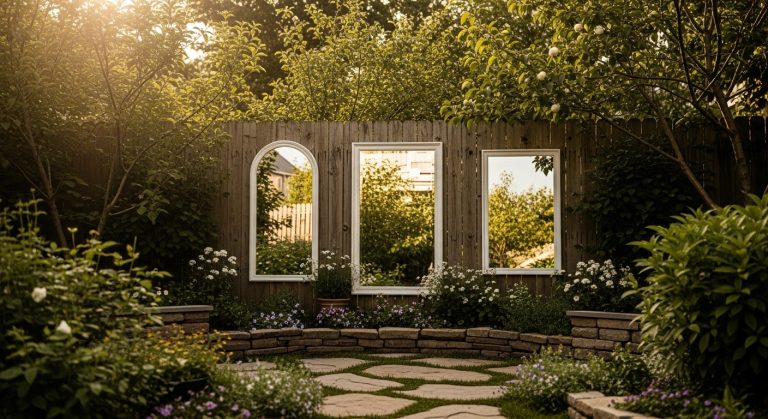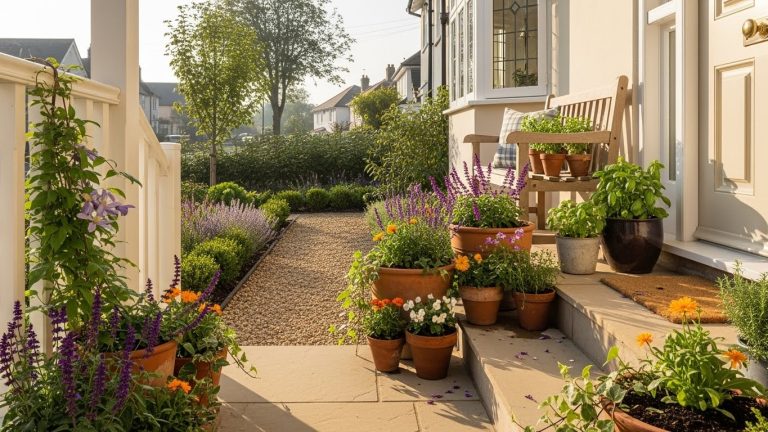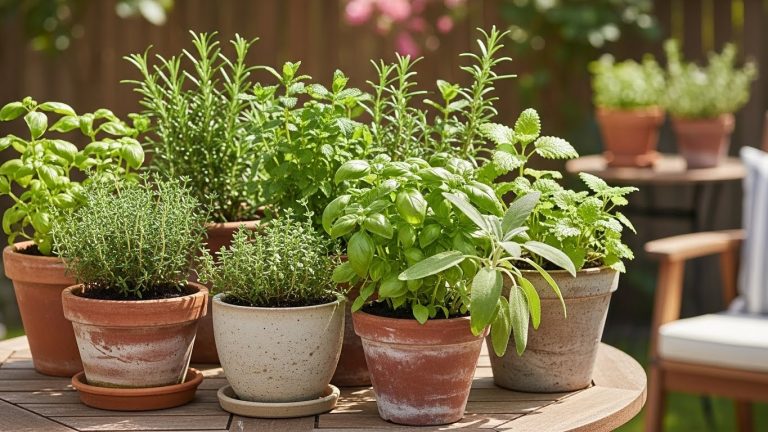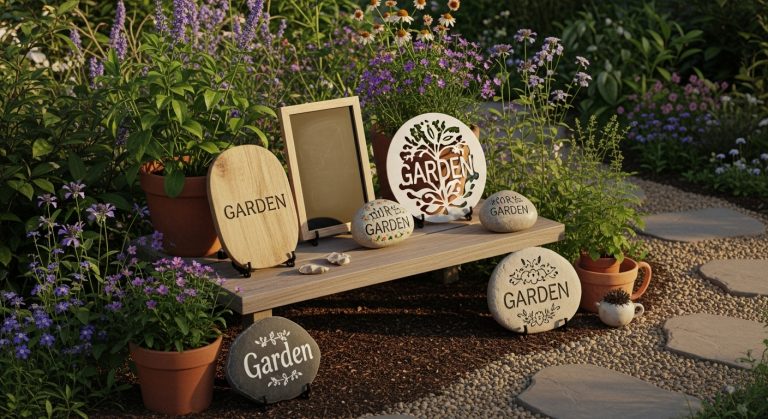Tulips Garden Ideas: 15 Ways to Brighten Your Spring
Ever walked into your garden after a long, grey winter and thought, “There’s gotta be something more than bare soil and tired shrubs here…”? I sure have. And that feeling hit hard the first spring I planted a batch of tulips. One moment the garden was asleep, the next I was greeted by vibrant, joyful blooms — and it changed me.
These cheerful flowers have an uncanny power to pull a garden alive. So today I want to share 15 true-to-the-garden tulip ideas for how you can make your space sing in spring. Whether you’ve got a tiny patio or a full yard, there’s something here for you. (Yes, IMO you can coax a last-minute tulip splash even if you skipped fall planting.)
Grab your gloves, maybe a coffee, and let’s talk tulips.
1. Mass Planting for Color Impact
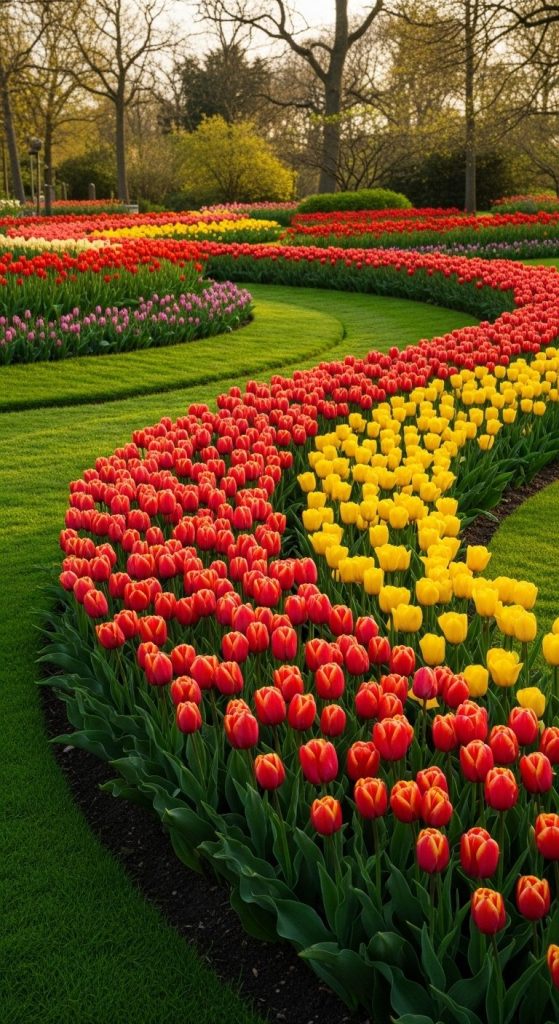
You know that “sea of color” effect at botanical gardens or parks? You can replicate it — on a smaller scale — by mass planting tulips in one area.
Imagine a sweeping swath of red, yellow, or pink tulips hugging the edge of your lawn. It’s dramatic, feels like a celebration, and plants your spring-garden flag firmly.
Pros:
- High visual impact — A large mass of tulips creates a jaw-dropping spring display.
- Simple setup — Choose your bulbs and plant them densely for a natural carpet effect.
- Defining feature — Instantly gives your garden a seasonal identity.
Cons:
- Cost and effort — Buying and planting many bulbs takes time and budget.
- Uniform look — Using only one variety may reduce depth and visual variation.
Takeaway:
If you’ve got the space, go bold. Mass planting tulips along a pathway or lawn border will give your garden a spectacular spring highlight.
2. Mixing Early and Late-Blooming Tulips
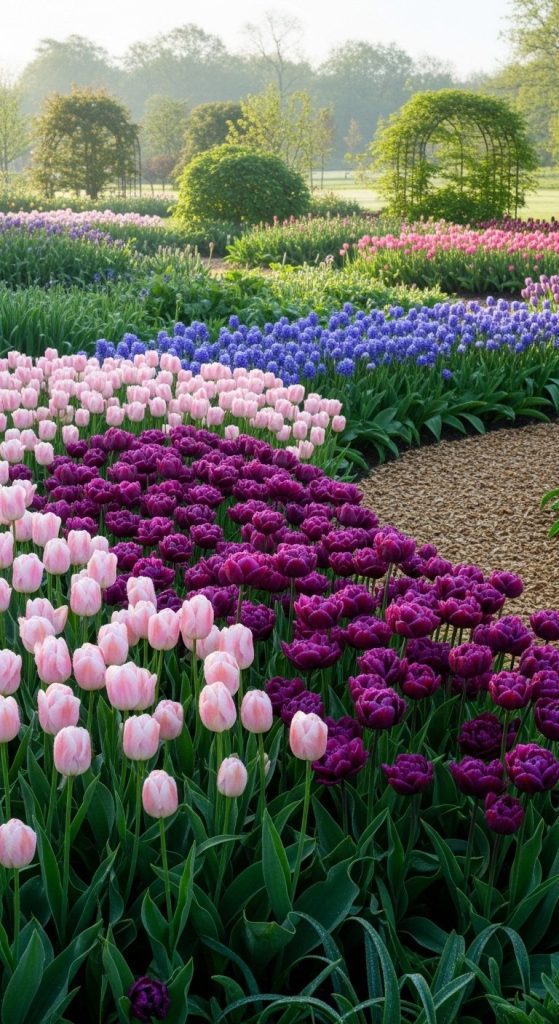
One of the best tricks is to mix early and late tulip varieties so your garden blooms for weeks instead of days.
That means your flower show doesn’t come and go in a blink — instead, waves of color appear gradually.
Pros:
- Longer bloom time — Enjoy tulips from early to late spring.
- Dynamic rhythm — Your garden evolves with new colors and shapes every week.
- More value — Stretch your display without adding more space.
Cons:
- Planning required — You’ll need to match varieties carefully.
- Possible mismatch — Timing may vary slightly depending on weather.
Takeaway:
Don’t settle for a one-week wonder. Mix bloom times for a tulip garden that feels alive all spring long.
3. Planting Tulips in Containers and Pots

No big yard? No problem. Planting tulips in pots or containers brings instant charm to small spaces.
A clay pot of bright tulips by your front steps can turn a dull entrance into a cheerful welcome.
Pros:
- Perfect for patios or balconies — Adds color where soil isn’t available.
- Eye-level blooms — You can admire them up close.
- Easy control — Great drainage and soil conditions are simple to manage.
Cons:
- Needs attention — Pots dry out faster, requiring more frequent watering.
- Limited lifespan — Some bulbs may not return as strong the next year.
Takeaway:
Containers are a perfect way to enjoy tulips anywhere — from doorsteps to balconies — giving you full spring joy in small doses.
4. Underplanting with Perennials
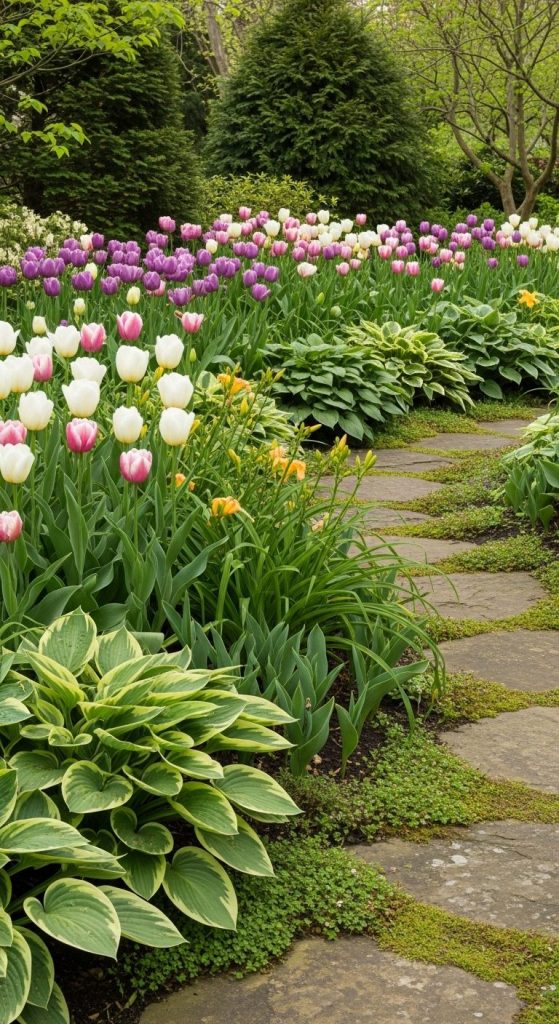
Once tulips finish blooming, their fading leaves can leave a gap. The fix? Underplant them with perennials that take over once tulips die back.
Pros:
- Smooth transition — Perennials fill in the space, avoiding bare patches.
- Layered beauty — Your garden has visual interest beyond spring.
- Efficient use of space — Two seasons of beauty in the same bed.
Cons:
- Requires planning — Choose perennials that don’t shade or crowd tulips.
- Potential crowding — Timing must be balanced for both plants to thrive.
Takeaway:
Pair tulips with companion perennials to keep your garden lively through every season.
5. Bold Color Combinations and Contrasts

Want your garden to pop? Use bold color contrasts — like purple and yellow, or red and white.
These daring pairings add instant personality and curb appeal.
Pros:
- Vibrant visuals — Contrasts draw attention and create energy.
- Creative freedom — Express your taste through color play.
- Memorable design — Guests will always remember your tulip palette.
Cons:
- Risk of clashing — Too many colors can look chaotic.
- Requires balance — Use neutral foliage or mulch to ground the look.
Takeaway:
Don’t fear color — embrace it. Bold tulip pairings make your spring display unforgettable.
6. Naturalising Tulips in Lawns or Meadow-Style Beds

If you love a soft, relaxed vibe, naturalise tulips through grassy edges or meadow-style beds.
They’ll bloom as if nature scattered them herself — effortlessly charming.
Pros:
- Whimsical effect — Looks spontaneous and organic.
- Low maintenance — Once established, they return naturally.
- Seasonal surprise — Each spring brings a fresh pattern.
Cons:
- Less control — Flowers may pop up unevenly.
- Competition — Grass or weeds can crowd bulbs.
Takeaway:
For a magical, natural feel, scatter tulips randomly through lawns or meadows — it’s like painting your yard with spring.
7. Vertical Displays and Raised Beds

Why keep tulips at ground level? Raised beds or tiered planters give them a stage to shine.
Pros:
- Better drainage — Tulips love well-drained soil.
- More visibility — Raised displays bring blooms closer to your line of sight.
- Layered design — Combine tulips with shorter flowers for texture.
Cons:
- Setup effort — Building or filling raised beds takes time.
- Drying risk — Elevated soil may need extra watering.
Takeaway:
Raise your tulips — literally. Elevated beds add structure and show off your flowers like art.
8. Companion Planting with Other Spring Bulbs

Combine tulips with daffodils, crocus, or hyacinths for a multi-layered spring show.
Each adds unique height, color, and fragrance for a full sensory experience.
Pros:
- Rich layering — Small bulbs in front, tall tulips behind.
- Extended blooming — Each species flowers at different times.
- Fragrance bonus — Hyacinths add sweet scent to your display.
Cons:
- Crowding risk — Too many bulbs can compete for nutrients.
- Visual chaos — Plan spacing carefully for balance.
Takeaway:
Mix tulips with other spring bulbs for a more textured and long-lasting garden performance.
9. Growing Tulips for Cutting

Why not enjoy your tulips indoors too? Grow them as cut flowers and bring that burst of color to your table.
Pros:
- Twice the joy — You get to enjoy blooms both outside and inside.
- Personal connection — Harvesting your own bouquet feels rewarding.
- Easy décor — Fresh tulips brighten any room instantly.
Cons:
- Short vase life — Cut tulips fade faster than garden blooms.
- Reduced bulb strength — Repeated cutting can weaken next year’s blooms.
Takeaway:
Plant enough tulips so you can snip a few guilt-free — they’ll make your home smell and feel like spring.
10. Tulip Borders and Edges
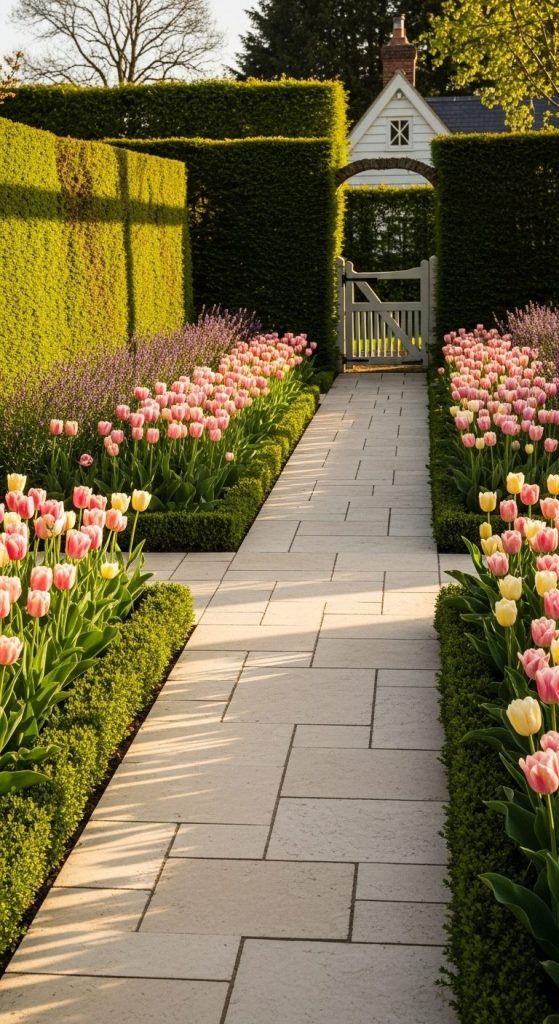
Use tulips to frame your garden paths or borders. They add structure, rhythm, and color exactly where the eye naturally travels.
Pros:
- Defined edges — Makes your garden look neat and intentional.
- Perfect scale — Works well between shrubs or along walkways.
- Easy updates — Replace bulbs seasonally for new color schemes.
Cons:
- Seasonal gap — Borders may look sparse once tulips fade.
- Repetition risk — Keep pattern variation to avoid stiffness.
Takeaway:
Tulip borders bring elegance and order — the perfect finishing touch to any spring landscape.
11. Mixing Heights and Shapes
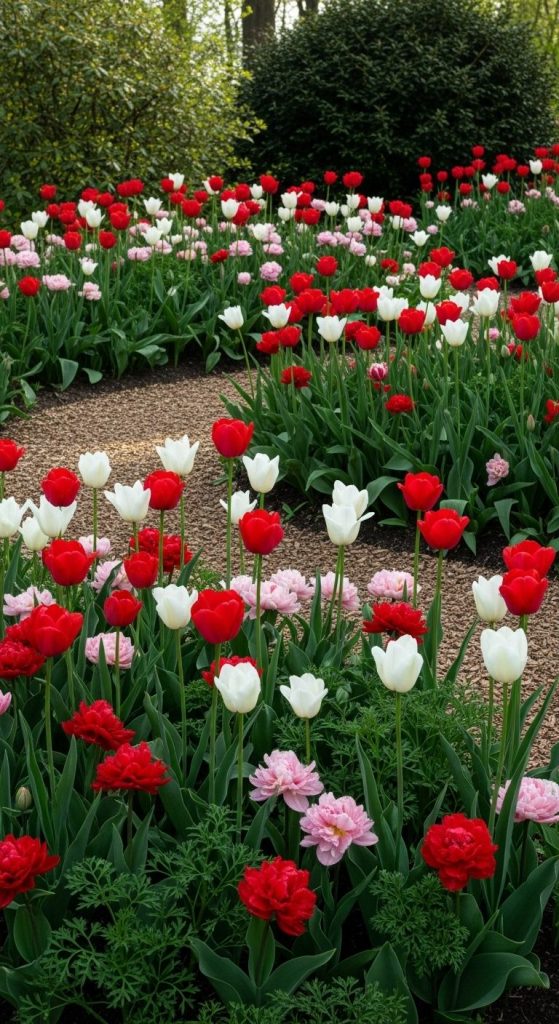
Tulips come in all sorts — short, tall, fringed, parrot, double.
Mixing different heights and forms creates a lively and layered visual story.
Pros:
- Depth and movement — Taller tulips sway above shorter clusters.
- Unique textures — Fringed or double tulips add intrigue.
- Creative freedom — Each shape adds a different mood.
Cons:
- Spacing challenge — Taller ones can shade smaller ones.
- Potential imbalance — Too much variety can feel disorganized.
Takeaway:
Vary height and shape to make your tulip garden dance — literally and visually.
12. Naturalising in Woodland or Wildflower Areas
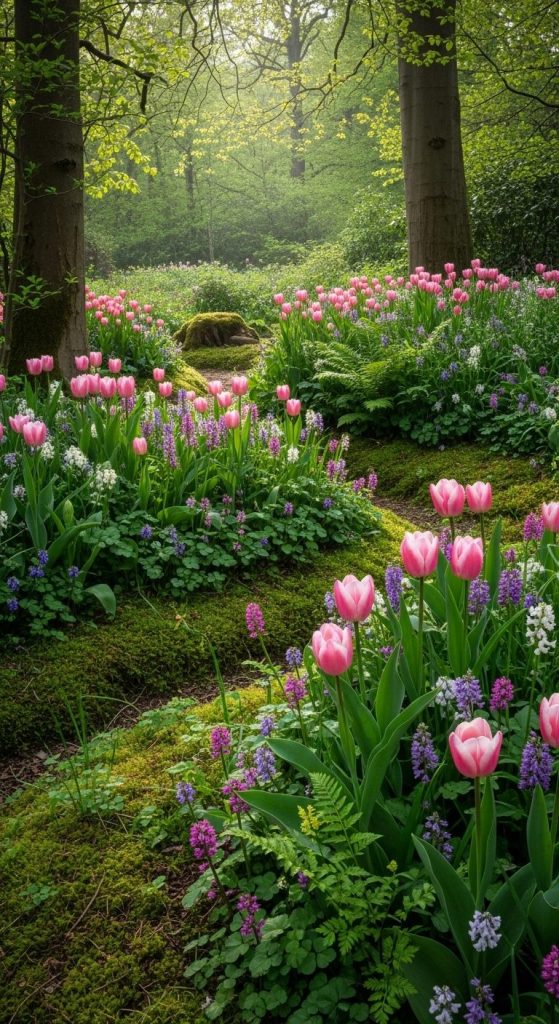
If your property has shady edges or open woodland, plant tulips among wildflowers for a soft, romantic look.
Pros:
- Effortless charm — Feels spontaneous and natural.
- Low upkeep — Once established, minimal care needed.
- Perfect for transitions — Blends cultivated areas into natural ones.
Cons:
- Hidden blooms — Grass or taller plants might obscure them.
- Less predictability — You’ll never know exactly where they’ll pop up.
Takeaway:
Let your tulips mingle with nature. Woodland and wildflower mixes bring out their quiet, fairytale side.
13. Tulips in Cutting or Kitchen Gardens
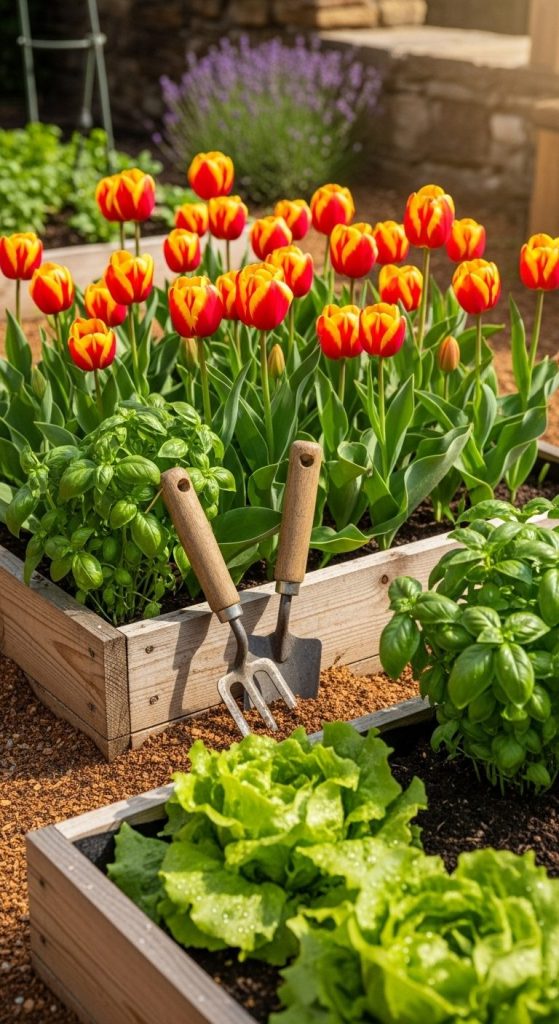
Tulips aren’t just for show beds — they belong in vegetable or cutting gardens too.
Their color makes edible spaces feel fresh and inviting.
Pros:
- Beauty and function — Flowers and herbs grow side by side.
- Seasonal interest — Adds charm to practical plots.
- Compact design — Works along borders or raised herb beds.
Cons:
- Soil differences — Veggies and tulips may need separate care.
- Messy look — Harvesting around flowers can disturb bulbs.
Takeaway:
Mix tulips into kitchen gardens — you’ll enjoy both productivity and prettiness in one place.
14. Using Unusual Tulip Varieties
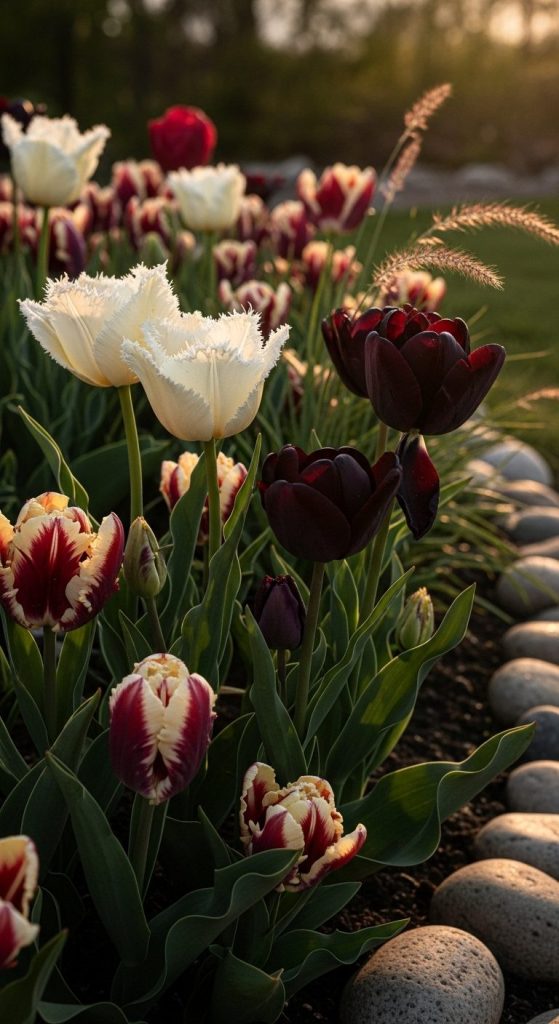
Step away from the ordinary! Choose rare or dramatic tulip varieties — like fringed petals, bi-color blooms, or deep maroon “Queen of Night.”
Pros:
- Instant wow factor — Unique blooms are conversation starters.
- Extended bloom time — Some unusual varieties last longer.
- Artistic statement — Perfect for garden photography or themed beds.
Cons:
- Higher cost — Specialty bulbs can be pricier.
- Limited availability — Rare types may sell out fast.
Takeaway:
Add a few unusual tulips for flair. They elevate your garden from “pretty” to unforgettable.
15. Planning for Re-blooming or Re-planting
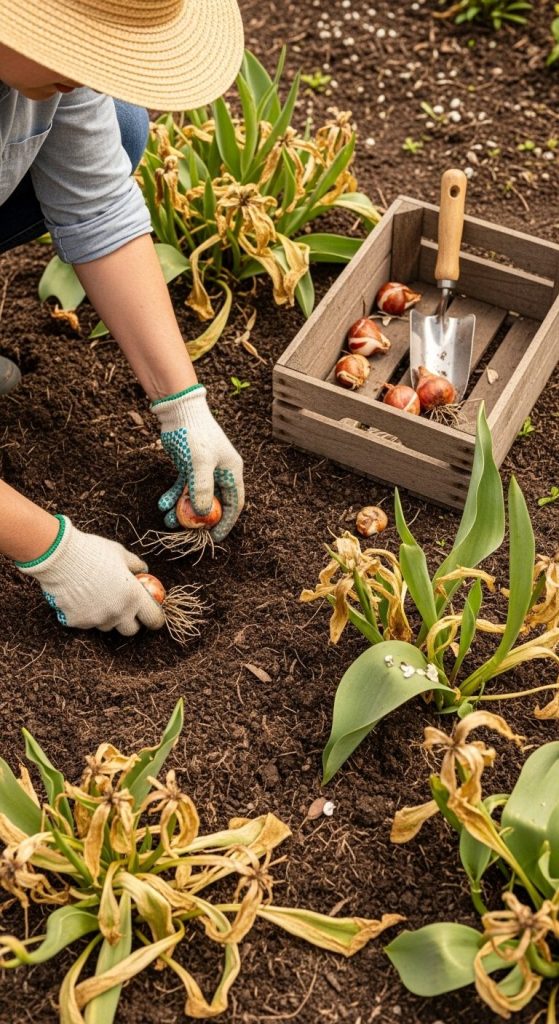
Let’s be real: tulips don’t always return reliably every year. Unless conditions are perfect, they may fade after a few seasons. So plan ahead — either lift and store bulbs, or treat them as annuals.
Pros:
- Realistic expectations — Avoid disappointment when blooms decline.
- Garden refresh — Re-planting gives you a chance to change your color theme.
- Improved results — Proper care ensures healthier bulbs next year.
Cons:
- Extra effort — Lifting, storing, or re-planting bulbs adds work.
- Inconsistent performance — Some tulips simply don’t repeat well.
Takeaway:
Accept tulips as a seasonal show. Whether you replant yearly or preserve bulbs, you’ll always have a reason to look forward to spring.
Conclusion
There you have it — 15 creative tulips garden ideas to brighten your outdoor space. From bold color blocks to natural woodland blends, from pots to borders, tulips have a way of making any space feel joyful and alive.
My personal favorite combo? Early and late varieties mixed with strong color contrasts — it keeps my garden changing every week and bursting with personality.
At the end of the day, gardening with tulips isn’t about perfection — it’s about pleasure.
Plant them, watch them grow, enjoy their show, and when next spring rolls around… do it all again, with your own twist.
Let your garden say: “Welcome back, life.”

William Martin is a passionate bowler who spends most of his weekends playing the sport. With years of intense experience under his belt, William decided to share his knowledge by creating BOWLING OCEAN. Join me on this journey to explore the world of bowling and discover the tips and tricks to becoming a pro.

